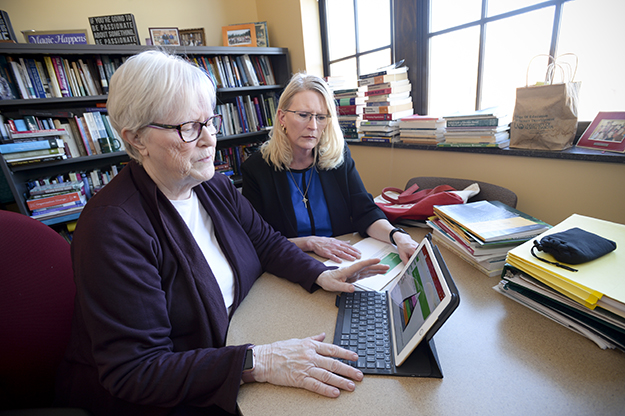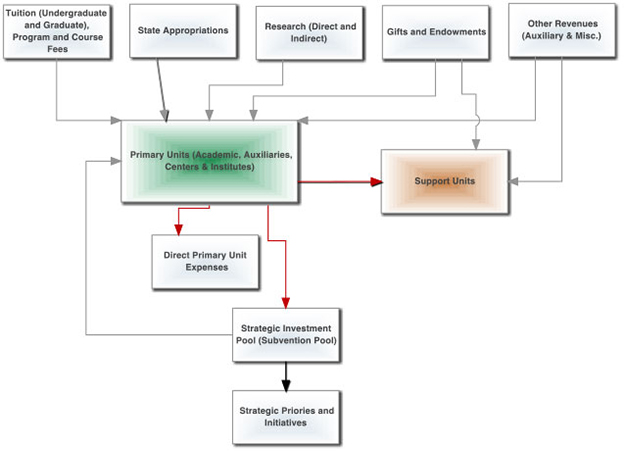Q&A: Making sense of MIRA
UND’s resident budget ambassadors peel back the mystery of the new incentive-based model

Odella Fuqua and Magaret “Margi” Healy are budget experts.
They speak the same language when it comes to line items, revenues and expenses — especially for large operations such as Universities and their myriad complexities and intricacies.
They’re also on the same page as it pertains to UND and its current budget situation, one that’s in transition from a traditional historical-based model to the Model for Incentive-based Resource Allocation (MIRA).
But Fuqua, UND’s director of resource planning & allocation, jokes that there still are times when she says something in budget lingo at a committee or group setting that Healy has to correct her on because few would understand it.
“She will tell me ‘I understand what you’re saying but that’s not how others will understand it … I think you should say it like this,’” Fuqua said.
Healy has a bit an advantage when it comes to administrative number crunching and making sense of it all. She’s seen it all. She’s done it all. And she’s taught it all, as well.
Healy has been working with budgets for 45 years. Before coming to UND to teach in the College of Education & Human Development, she spent 30 years as a university administrator, culminating with her position as vice president for student affairs at Mankato State University.
Today, as a professor of Educational Leadership at UND, she prepares people to be University administrators.
But she’s also working hard with Fuqua to make UND’s transition to the brand-new budget model easier and more understandable for the campus community.
Both recently sat down with UND Today to lay out the basics of MIRA and how faculty and staff should embrace it rather than run from it.
Q: Why did UND opt for a Responsibility Centered Management (incentive-based) model such as MIRA over the historical incremental model that the University had been using for budgeting?
O.F. In August 2013, UND went through a consultant guided process to evaluate what budget model would serve UND best. After interviews with over 30 leaders on campus, it was determined a change from the historical incremental model would be best for UND.
After that, we asked, ‘What is the right model?’ We ended up with a Responsibility Centered Management incentive-based model.
The model’s underlying premise is that the decentralized nature of fiscal management entrusts academic leaders with more control of financial resources, leading to more informed decision-making aligned with the mission and strategic vision of UND, which, sometimes, might change under new presidential leadership. The goal is to have better results or outcomes for UND as a whole. These changes will be guided by five principles consistent with our core mission and values, all of which support students’ educational experiences:
- Allow UND to focus on strategic priorities
- Promote transparency
- Improve efficiency
- Improve the quality of service provided by UND
- Allow growth initiatives to flourish
M.H. UND, for as long as I’ve been here, and I would suspect a long time before that, has used a historical budget model that has been widely used in higher ed … it’s predictable – what you got last year, you’re going to get next year – you know where you stand.
The problem with a historical budget model is it doesn’t allow you to be innovative, there’s not a lot of resources available for taking a risk on a new idea.
The other problem with it is that the money didn’t move with the students. Jobs and professions, over the years, fluctuate and that fluctuation in professional opportunities could be seen in the majors as well — but you still got the same amount money regardless (under the historical model). So the changes in enrollment didn’t yield a change in funding… that’s fine if your enrollment goes down, but not so fine if your enrollment goes up.
Q: So MIRA is more flexible, or reactive, to these variables in comparison to the historical model?
M.H. The historical model doesn’t react at all. It simply doesn’t respond to the flow of students through the University.
Q: In what ways can MIRA make a big organization such as UND more efficient?
O.F. MIRA gives you a different view into your numbers, and has, in some cases already, created some ‘ah ha!’ moments.
It’s always been said, if ‘you want to know what your priorities are, look at your checkbook.’ That’s where you spent your money. MIRA does that for us. It gives people a chance to step back and say, ‘oh, is that what we want?’ ‘Is that what we should be spending our money on?’
MIRA caused us to look at things differently, and in those discussions, we’re finding efficiencies and effectiveness and how we can do things differently.
Q: Where does the University get its money and how does it flow?
O.F. The revenue streams are tuition – undergraduate, graduate – state appropriation, grants and contracts, gifts and alumni support, and other sales and services — miscellaneous, student fees and mandatory fees. Those are really your main revenue streams that flow in.
The vast majority of the revenue is flowing to revenue-generating units, what we call the primary units: Colleges, Schools, Auxiliaries, Centers and Institutes.
The support units, in some cases, do produce small amounts of revenue, but their main focus isn’t to do activities that generate revenue. Their main job is to support the primary units in their revenue generation.

Q: Can you explain the intended purposes of the designated pool of money for “subvention” and “strategic investments”?
O.F. As part of MIRA, every primary unit pays a participation fee that goes into a pool. That pool is then used to ‘subvene’ units that operationally cannot balance (they don’t generate enough revenue to cover direct expenses). So, subvention balances them out. It’s not a blank check, it’s not an entitlement. Every year they have to request it.
The reason for it is that we know, in some cases, it’s more important for us to have these units. They add value; they add importance. So this is a mechanism for providing them with the appropriate funds.
M.H. Stepping away from UND, as an example, I’ve been part of accreditation visits to small Christian institutions. They would have theology departments but they didn’t have enough majors or they didn’t generate revenue to support the faculty they had. However, those theology departments most likely were written into the institutions’ charters, they’re part of their missions. If those institutions used MIRA, or an incentive-based model, they would use subvention funds to keep them afloat because those departments are mission critical. They can’t be that kind of college without those departments.
O.F. Strategic investment is the other part of that pool of dollars. It’s available for primary units only (because they’re the ones paying into it) to say ‘I need some seed money to start a new program that in two years will be able to support itself, but I need that loan first to get it going.’ So, strategic investment is truly seed money.
Q: So, under MIRA, there is a pool available to primary units to draw from and influence the current budget. But, what about support units? In this time of transition, how might they similarly affect the budget process?
M.H. Historically higher education has not done marketing for new students or for institutional reputation or for institutional positioning … largely our market position was driven by our athletic conferences and our performances on the athletic fields.
Now we understand that we need to market and we need to build a brand and a reputation in order to accomplish our purposes. We also know that we need to be intentional with social media and the Internet environment — or we will be harmed.
But in a historical budget model we didn’t have much money invested in marketing, so, in order to respond to 21st-Century demands on institutional reputation and identity, we needed to make an investment, we needed to be able to shift the money.
The normal MIRA process would allow us to do that kind of marketing … but, if you have an idea now, you’d be talking about influencing our budgets in 2018-19 and beyond. We couldn’t wait that long.
So, in this transitional period between budget models, we are choosing to make some strategic allocations now in the form of marketing.
O.F. If you have $1 to invest … you can either give it to one of the 23 primary units — but then you’ve only increased that primary units marketing — or you can invest it in the marketing support unit, and you’ve just increased the bandwidth for everybody. So that type of investment is really a centralized investment that helps everybody.
Q: How can faculty and staff members influence the budget under MIRA?
M.H. It’s easy for us to assume that we’re just sitting in our offices and not affecting the budget. But how we use our time has financial consequences. A lot of the influence is performance based. For example, if professors take the extra step to check up on students that have disappeared from class and get them on the right track, they also keep those tuition dollars coming in. By adjusting your position to the changing climate, we benefit the institution.
Also, faculty and staff who are interested should get involved with their program early and often. Talk about innovation and what you can do differently, make proposals to your dean or your director on how you can do your work more effectively. And sometimes that might mean to stop doing something or to stop spending money. Sometimes it might require new money and sometimes it might be a suggestion that ‘instead of doing that, let’s do this with our money.’
If you’re interested in being involved at a higher level, ask your dean or director how you might get involved early when the budgets are being built.
Also, there are three institutional decision-making committees particular to MIRA. They are the University Curriculum Committee, the University Space Management Committee, and the Support Unit Allocation Committee. Those are all places that people can get involved.
Faculty representatives are selected by the University Senate. Staff members on these committees are selected by the Staff Senate. And student reps are selected by Student Government.


